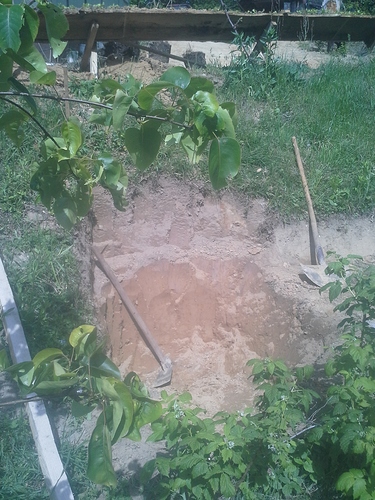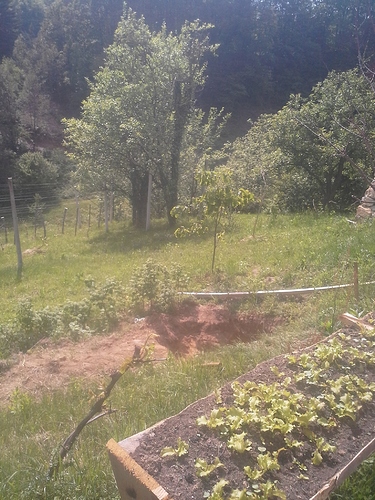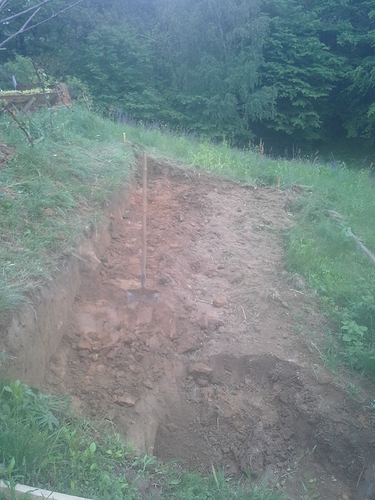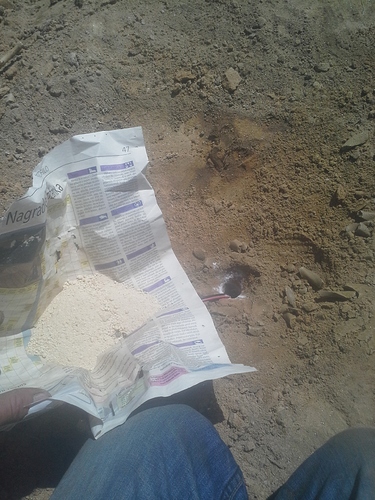Greenhouse CO2/humidity/temp meters or safety CO2 level meters are available for around $100 and up.
“Lots of ideas less time and no money. Good things take time.”
Story of my life. Specialy the no money part 
Interasting concept thugh. It was allways my dream to have a winter garden connected to the house. Well, actualy more like a tropical living room. Imagine sitting on a comfy chair with lemons, oranges, cinnamon, cardamom, ginger and other exotics thriveing around you while there is a foot of snow a few steps further. Priceless. I have been to one like this, l fell in love. But the current house unfortunaly doesent allow it… Perhaps some day.
Some interasting numbers. If one culd burry and insulate a 70m3 container somewhere, one wuld never need any aditional heating. 70m3 of water culd be heated in the summer by solar heaters and accumulate enough energy to provide a constant 2kw heating value. But thats a big container. And l have no idea how to insulate such a quantity of water.
Anny ideas?
I don’t know much but I do know the heat lose is tremendous. With no heat I had temps in the -30’s f. It is a great season extender on both ends and a big help on home heating for a few months on both ends. Unfortunately we don’t get any sunshine from the end of December till the end of February. If you could keep it warm enough the best you could do is sustain life, no growth. Artificial lights will produce lots of heat but if one is going to use them may bc as well do it in the house where the heat is also enjoyed by you and replaced heat from another source. Heat ad light for one money.
The University of Minnesota is working with growers on designs for Deep Winter Greenhouses.
The information and plans can be found here http://www.extension.umn.edu/rsdp/statewide/deep-winter-greenhouse/
These greenhouses have been able to grow stuff all winter long without added lights and little or no added heat. We had one of the guys out to do a presentation. They currently have 5 greenhouses they are monitoring for performance and heating requirements. They opted for electric heat for ease of measurement but it sounds like it is rarely needed. Some limited electric required to runs fans to store the heat in rocks under the greenhouse. They pay very close attention to sealing up any air leaks and have lots of insulation.
Hmm interasting. This concept looks like a more efficiant one (less of the surface is exposed glass or foil so less heatloss) and cheaper.
Ideas are sprouting with each post so keep them comeing guys, thanks!
Wouldn’t there be a risk in an enclosed space that a TLUD could use up enough oxygen to become a CO generator?
Here’s an article on eutectic salts, and greenhouse approaches for cold climates.
http://smallfarmcanada.ca/2016/chill-out-storing-heat-inside-a-greenhouse-using-salt/
I feel that no matter how good the setup, the heat losses from the glazing on a greenhouse will meet a point of impracticality in extreme cold, the R-value / U-value of even the best windows is just too low. Also, the extra insulative value is only gained with great added cost.
I think in extreme climate, a solarium / 3 season greenhouse attached to a heated building is probably optimal. Insulated shutters will be the only other way to reduce heat losses.
I have to say that mine was not sealed or insulated this past first winter. Even so the solar Gane in the house fall and spring probably saved me 1/2 cord of wood.
I wish I never started with the solairm but rather stick framed it with an insulated roof and 60degree sloped glazing only on the south. I am hoping to find a roll up RV awning for shade but may just put my solar panels up there. Though not ideal but more effective than in the closet.
George, that greenhouse in Finland MN is about a half hour north of me. I would like to stop in and take a look at it.
You might be interested in the walipini. (there might be better articles on it, it was just the first one.)
There was a guy from I want to say sweden that was heating hothouses and producing electric with wood gasifiers for commercial production. I saw a youtube video from him once. It was a pretty large system.
In this area, you can find old double paned windows now for free. However the plastic hoophouses are fairly popular since they are cheap and easy to construct.
Did a vertical TLUD that ran a little better than 2kw for 13 hours some years back. The fill and burn chamber were less than 3 feet tall. Stack added another 3 feet. Have built many 2kw TLUDs that burn smoke for 8 hours for friends. Have also done horizontal pyrolysis using TLUD concepts.
In your case, for extended run time, an angled TLUD may be the ticket. Have yet to do one but been thinking bout it ;~)
In most TLUD designs, when the smoke burning stops, the char burning begins. Which means extended heat output at much lower rate (in my experience char kept burning for two days and char remained.)
Perfect combustion is what we seek. Creates carbon dioxide and water. Both great for plants. Plants return oxygen in the bargain.
That said, moisture buildup in an enclosed greenhouse can be problematic, promoting fungus and etc.
Check into thermosiphon for moving water through the greenhouse for heat where you need it. Simpler than it sounds. Best system I have personally seen to date is open at highest point so no accidental boiler.
An angled TLUD operating in batch mode could meet your spec with a reasonably standard fuel and careful design. Using water for heat storage and getting the temps into desired locations makes sense.
Moisture will likely be the “gotcha” running unvented. There are heat recovery ventilators that run off a humidistat to control humidity in the space, but then you are talking electricity.
With a large enough expansion chamber and rapid enough cooling from the water you could exhaust through a tiny pipe near the floor and maintain draft. But water exiting could freeze during extended low temps. A known issue with HRV’s.
It makes sense to save char - make useful downstream product while heating.
Cheers and best wishes. Grow baby grow!
How about an enclosed TLUD, following the Keystone stove concept? Could still derive the long burn times mentioned above, but sealing will avoid condensation and ventilation issues. For maximum efficiency and to avoid uncontrolled air infiltration a cold air duct from outside would be used.
The heat could be recovered from the flue into a thermosiphon storage, then released either by convection, or a small circulating pump.
Thanks for all the ideas and guidence guys, its much appreciated!
So, here it goes!
Its goeing to be a walipini stile greenhouse. l am not 100% sure what the end design will look like, all l know right now is brute dimensions l need, l know l like the underground concept, and the greenhouse will be fited with a efficiant long lasting wood burning heater.
Ha, there will be a lot of pork and wine fuel neaded to perform this digging, a couple of feet of soil, then sandstone. Need to dig 8 feet deep, 10 wide and 20 long.
Looks like you plan to dig the hole by “hand”. Don’t you have something on the farm to dig with like a skid steer, or front end loader on a tractor? Can you use some of that gun power you made to loosen up the sand stone? I can’t imagine digging that size hole using a pick and shovel to get through the sandstone. Good luck. TomC
Hi Tom,
Yes we have some mechanisation but l am not able to acces the pit its on a hill surrounded with a vineyard and fruit trees l amnot willing to destroy.
The topsoil is fluffy like playsand, but the sandstone is a pain. Fofget about blackpowder, it just finds a crack on the rock and puffs trugh. Tryed it allready before. Higher explosives are required, with a high detonation velocity so that the shockwawe pulverizes the sandstone. Then its shovel once again 
Kristijan,
Shovel works good even for big size holes. People often forget to add the amount of hours spent bringing heavy equipment in and maintaining them to the total effort. Who knows, you might even have a new gasifier construction redy in your head after spending some time with that shovel 
I just skimmed through this there are some great ideas. I would add some sort if covers for the glass when the sun goes down. You loose alot of heat through glass in the dark.
Also check out this book
Eliot Coleman
Four-Season Harvest: Organic Vegetables from Your Home Garden All Year Long, 2nd Edition
There is a design in it for some very simple beds with doors covering them that the author claims work in Maine year around. Also alot of talk about what plants can survive the winter cold.
Shovels are in action!
Some help from chemistry.
the only machine part, loading the dug out sand
Thanks to you all for ideas, each reply was much appreciated in the design!
I like the chemistry, what is that you are using?
Kristijan, I´m getting dizzy. When do you sleep? Hay making, digging for greenhouse and a new filter disign. I come to think of Woody Woodpecker running around in the Donald Duck series. I feel 90 just looking at all the things you´re up to. I managed to sneak away chunk another trailer batch of wood today, that´s all. We´re having mothers day today and time consuming, mandatory cake and coffee.










